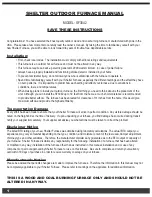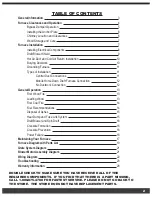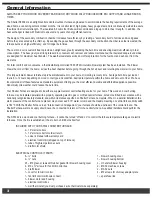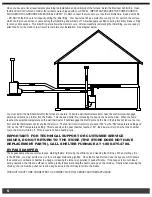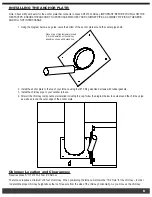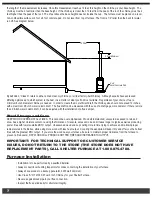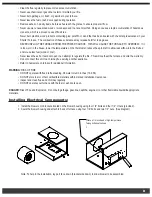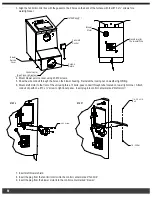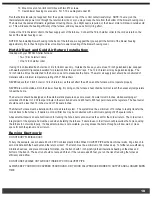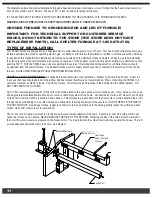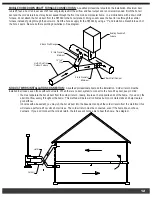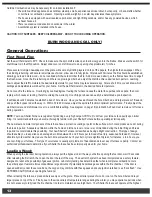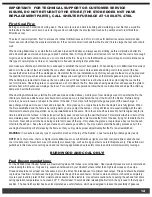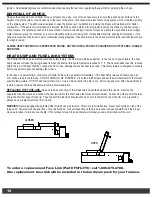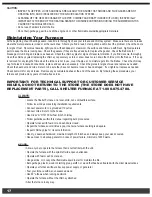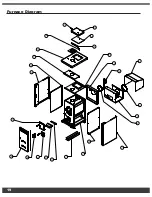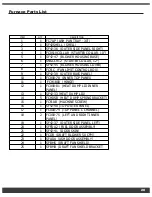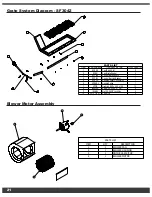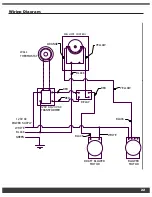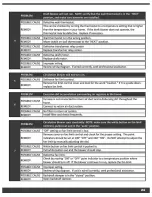
10
10. Mount cover on fan limit control box with two #10 screws.
11. Caulk blower housing cover seams. For 7-10, see diagram under #3
Run the thermostat wire (not supplied) from the 2 posts located on top of the control center transformer. NOTE: You may run the
thermostat wire and power cord through the return cold air duct, or you may access the hole from the bottom of the blower housing cover.
The hole must be sealed afterward, regardless of routing choice. An airtight seal is required, or the blower motor will draw in outside cold
air. This will reduce the heating efficiency of the furnace, and may cause a short cycling effect.
Connect the 10 inch starter collar to the heat supply vent of the furnace. Connect the 12 inch starter collar to the cold air return on the
back of the blower housing cover.
NOTE: When installing blower housing to the back of the furnace, we suggest that you support the bottom of the blower housing
approximately 6 ¼ inches from ground level to allow for easier mounting of the blower housing cover.
Hot Air Duct and Cold Air Return Installation:
Included with your SF3042 Shelter Furnace:
• Two 10 inch starter collars
• One 12 inch starter collar
If using 10 inch insulated flex hot air duct, it is for indoor use only. Outside the house, you must use 10 inch galvanized pipe, wrapped
with weatherproof UV-jacketed insulation for protection from the sun’s UV rays. The 12 inch return air may be galvanized pipe. The
12 inch return air must be attached to the home so as not to pressurize the home. The warm air supply duct should be constructed of
materials with a minimum temperature rating of 250° Fahrenheit.
NEVER reduce the 10 inch hot air or 12 inch return air, as this will affect the air flow and the furnace will not operate properly.
NEVER draw cold outside air into the blower housing. By doing so, the furnace’s heat chamber will not reach the necessary temperature
to heat the home.
The duct work should be designed so the external static pressure does not exceed .02 water column inches, while developing air
velocities of 600 feet to 1,000 feet per minute in the main trunk duct and 400 feet to 600 feet per minute at the registers. The heat outlet
should never be less than 10 inches round or 79 square inches.
The Shelter Furnace must be installed with a cold air return system. The system must be a minimum of 12 inches to readily transfer the
cold air back to the furnace. If desired, a cold air filter box may be constructed with a minimum opening of 225 square inches.
A basement window is an excellent location for running the hot air duct vent as well as the vent for the cold air return. The cold air is an
integral part of the system and must be used when installing the furnace. Failure to use cold air return will pressurize the home causing
the furnace to not work properly. If a basement window is not available, you may access the home through a window, wall, or crawl
space for both the plenum and air return.
Burying Ductwork:
DO NOT BURY FLEXIBLE DUCT.
To bury the ductwork, use schedule 40 or 80 PVC or black plastic DUAL WALL CULVERT PIPE with smooth inner walls. Dig a trench to
accommodate both the heat duct and the return air duct. The trench must be a minimum of 24 inches deep. To further ensure efficiency,
minimize heat loss, and prevent moisture formation, line the trench with 1 inch pink Styrofoam insulation sheeting on the sides and
bottom of the trench. The duct run should not exceed 25 feet. If the run exceeds 25 feet, you run the risk of reducing the furnace’s
efficiency and airflow.
DO NOT USE FLEXIBLE HOT AIR DUCT INSIDE PVC OR CULVERT PIPE.
ALWAYS KEEP YOUR WOOD COVERED YEAR ROUND. DRY WOOD WILL PRODUCE MORE BTU OUTPUT AND A LONGER BURN
TIME.
1/4 - 20 x 3/4
Bolt


